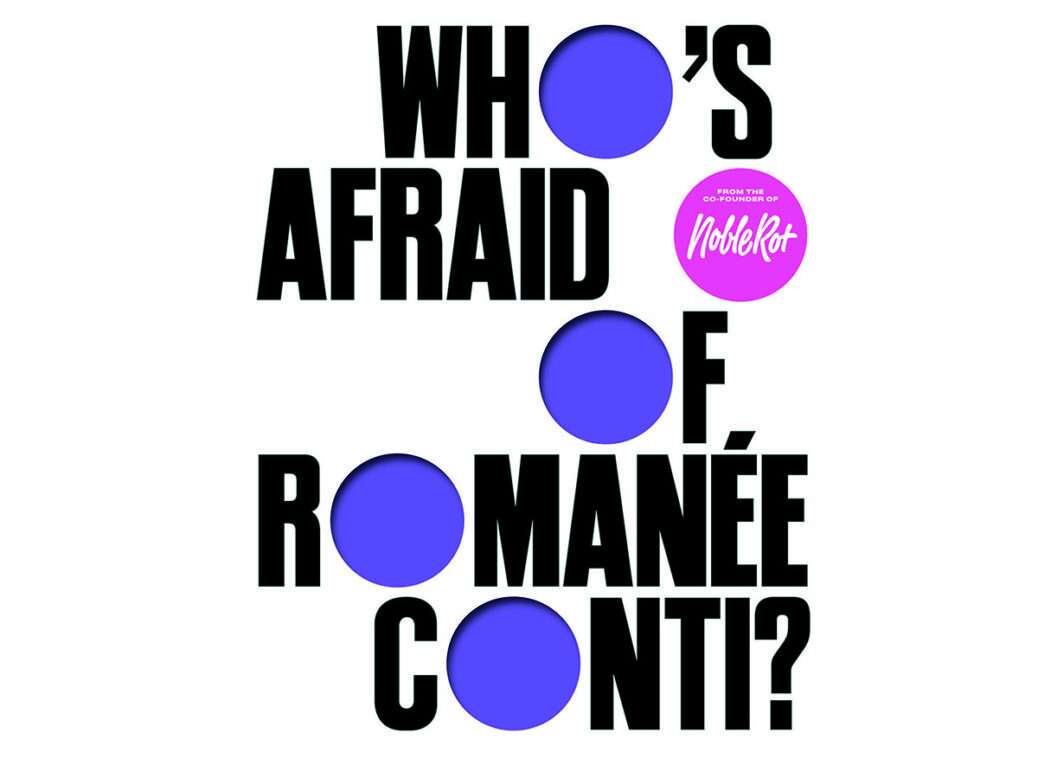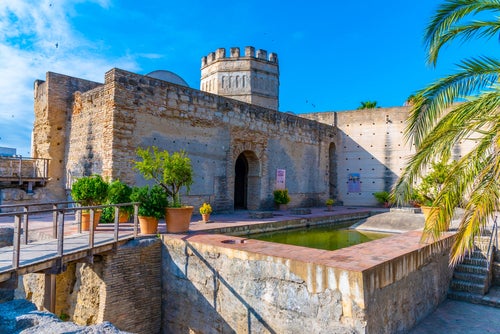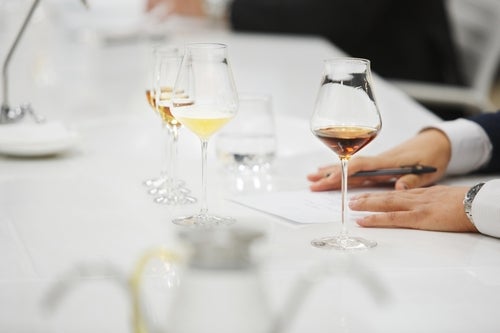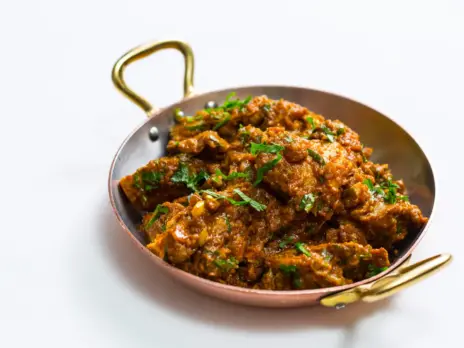
Brian St. Pierre reviews Who’s Afraid of Romanée-Conti? A Shortcut to Drinking Great Wines by Dan Keeling.
If you had enjoyed an especially lucrative Christmas, landing a bonus, dividend, or something beneficial from a well-heeled ancestor, and were walking down Lamb’s Conduit Street in London soon afterward, you might have been tempted, even seduced, by a chalkboard list in the window of a restaurant: A by-the-125ml-glass wine list, in fact, but as far from the usual come-hither beckoning as most of us are from Outer Mongolia. (Gravner’s austerely sturdy Ribolla Gialla 2010 at £32, Pichon-Baron 1989 at £86, or Yquem 1989 at £135 were among the 15 extraordinary wines that caught my eye, but not my deflated wallet.)
The restaurant is called Noble Rot, part of a small empire of wine-oriented restaurants and other ventures. The attitude of its founders is especially notable in their off-piste and upbeat magazine of the same name, a mildly but firmly disruptive periodical—rumpled, informal, and casually cheeky, going its own way in its own moderately mannerly and knowing style, where offhand reports may include how actress Keira Knightley enlivens filming with wine tasting, or that sportscaster Gary Lineker is good company to hang out with over an expansive and quite liquid lunch, or if England’s best restaurant writer Marina O’Loughlin is still on form (she is). The sprawling manse of wine may have many chambers, but Noble Rot’s particular suite of exuberant neon-lit playrooms is as cheerfully busy as the sommeliers’ station at an oligarch’s birthday party.
Now, however, comes another surprise, reflected obliquely in its title—this book is a serious compilation of ruminative essays and interviews (though of course never somber, and not in the least schematic), interspersed with recommendations offered as concise “shortcuts to drinking great wine.” It’s an assemblage of idiosyncratic, well-researched, down-to-earth, and on-the-spot dispatches from the front lines of change (at least in Europe, it should be noted) by Noble Rot co-founder Dan Keeling. There are a half-dozen utilitarian chapters dutifully providing advice on how to at least begin a search for some of the large flock of rare birds he adores with online tools and reliable merchants and importers, and what to do to enhance them if and when you capture them, such as aging, serving, and even—in a casual sort of way—talking about them, but he’s mainly determined to shake up a lot of fundamentals, cheerfully disassembling received wisdom, razzing established hierarchies, and unabashedly in love with, as he writes, “the mysterious puzzle of vino,” as he cheers the idea that “the absence of certainty is part of the deal” with truly fine wine.
Whether or not you embrace that thought, the considerable array of “shortcut” recommendations that follow most chapters (definitely not rankings) provides useful insights and markers for many of the regions pointing the newer ways (as in “greatness comes from unexpected places” that avoid “the negative appellation trap”), vignerons reinventing styles (“Chianti not Chianti,” unfortified Sherry from “the yeastie boys” of Sanlúcar de Barrameda, or dry “new-school classics” made without much intervention and “full of life” from Chenin Blanc in the Loire Valley).
Heart-on-sleeve certitude
Throughout, change is certainly on the itinerary, a ripe target in much of Europe, where a long and involved wine history provides much for the author and an expanding cohort of younger wine producers to argue with, which they appear happy to do, aiming to seed a new consensus, questioning established assumptions and chucking some cherished ones overboard, especially those arising from generational differences and an army of international consultants mired in the trenches of “typicity.”
It’s an attitude advanced with heart-on-sleeve certitude: “Where you grow grapes still matters. But AOCs, PDOs or any other bureaucratic POVs don’t create wines worth falling in love with: dreamers do,” Keeling declares, sets out to prove, and mostly succeeds. It’s sometimes a wild ride, with numerous sharp turns, an abundance of puns in the road, and little room to argue with the articulate but talkative driver. The destinations may be just off the beaten track, but we’re firmly assured that they’re well worth a few detours.
He has a point, of course. Take Vin Jaune, the yellow wine of Jura, for example—umami on a rampage, snoozing under a veil of yeast for years, gaining richness, but also a generosity he describes as peculiar: “For some, fermented yak dung is more enticing,” he writes. “For others, it’s the most exciting taste-bud ping-pong imaginable.” To say, as one winemaker does, “It’s always surprising,” is the understatement of the decade, but the wines are being rediscovered, lately gaining traction, and if Keeling’s love letter doesn’t at least entice you into a taste, you might just need your batteries recharged.
Then there are Swiss wines, those notable stay-at-homes. (Not a question of traveling well, more of the way that “the locals don’t care much for sharing.”) It may take as much patience and digging to find the really good ones as it took to establish vineyards on the slopes of Valais (“working this gigantic granitic amphitheatre has more in common with rock climbing than farming,” he quips) but, as he enthusiastically goes on, when you pair a first-rate Fendant with raclette, you’ll have proof that this particular mix of potatoes, cheese, and tangy garnishes can be “a gastronomic wonder” with a place at the top table if it has the right accompaniment. He also highlights Petite Arvine, the best of which lightly redefine nervosité, worth a serious search and happy to mate with lean freshwater fish, grilled and herb-buttered, or smoked.
Overall, there’s so much emphasis in these pages on what’s new and natural, offering discoveries of “character over consistency,” that it comes as something of a shock suddenly to find the author mounting a rare, and judicious, defense of sulfur, the “little brimstone” that’s been denounced and demonized so often and loudly in recent years. “Considering sulphur is the fifth-most abundant element on the planet […] I never understood the obsession with eliminating it at all costs,” he writes, before interviewing and tasting with no-and-low-intervention winemakers (several of whom have moved from the former to the latter), after which he concludes, “Natural wine’s great achievements—improving farming and minimising generic winery technology—should be celebrated with gusto. But thank god a few more of us can agree that a little bit of brimstone is not worth a war.”
It’s quite possible to differ with Keeling’s tone, emphases, or multiple choices—this is a free-spirited, free-form buffet rather than a methodically planned banquet, thrown together by a well-traveled, energetic, and eager chef with an unlimited larder, and an ear for the distant echoes of disruptors from a couple of generations past, of the assertive noises of a young Robert Mondavi, Angelo Gaja, Nicholas Joly, David Lett, Josko Gravner, Randall Grahm, Alejandro Fernandez, and other wide-awake “dreamers” intent on crafting “distinctive wines that have something to say.” Fill your plate and dig in, don’t skip the anarchy around the edges. Bring a hearty appetite and an open mind, and you can’t lose. After all, of course, despite the hubbub, there’s a firm response to the titular question, when the lucky author sits down to “the anxiety and the ecstasy” of a tasting of 25 vintages of Domaine de la Romanee-Conti hosted by Aubert de Villaine, the genially magisterial keeper of the ancient domaine’s flame. Change is fine, but it’s not everything, and the long arc of consistency, as manifested here, is “as close to sensual nirvana as it’s possible to get without divine intervention.” As another panelist, Michel Bettane, remarks, “No one—no super-rich collectors—could do what we are about to do.” Tasting notes are not often fun to read, but Keeling leavens his with astutely celebratory background about Burgundy and amusing asides about what it’s like to land on this peak. Altogether, here’s a good set of reasons to keep cheering on those looking up to it and climbing.
Who’s Afraid of Romanée-Conti? A Shortcut to Drinking Great Wines
Dan Keeling
Published by Quadrille; 285 pages; $45 / £30






